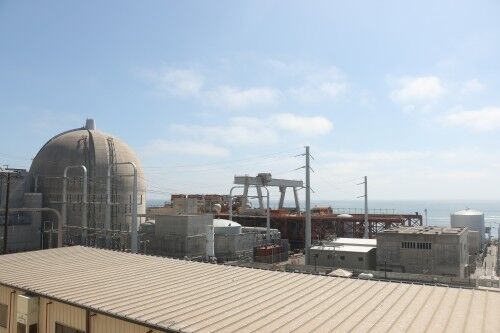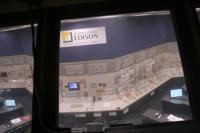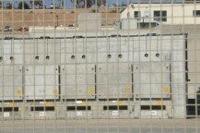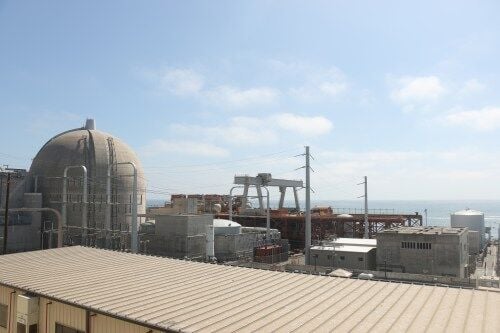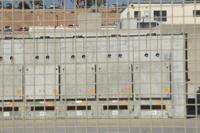SONGS officials give media tour before deconstruction takes place

Unit 2 of SONGS is planned to be torn down starting in late 2017 after the plant is fully decommissioned. The dome is made of concrete that is 5 feet thick and tons of rebar. Photo: Eric Heinz
By Eric Heinz
As San Onofre Nuclear Generating Station looks to decommission and eventually disassemble, the San Clemente Times was invited to tour the power plant before the area is returned to its natural state.
Tom Palmisano, Southern California Edison vice president of decommissioning and chief nuclear officer, said the power plant has many steps to go through in decommissioning before the physical plant can be deconstructed. SCE is the majority owner of SONGS.
“There’s a number of preliminary things we need to do,” Palmisano said. “We’ve changed our (Nuclear Regulatory Commission) licensing to match the decommission state. We’re completing the first part of the Coastal Commission reviews to expand the spent fuel storage.”
Palmisano said the local support to encourage federal action in removing the fuel and storing it somewhere other than the coastline has been appreciated.
“We will complete the remaining California environmental reviews, and in approximately two years we’ll start the actual dismantlement,” Palmisano said. “At the end of our timeline, we’ll reduce the operating license…until the DOE is ready to take the fuel, we’ll continue to store it safely.”
The entirety of removing the current nuclear power plant will take about 10 to 20 years as the remaining nuclear fuel at the facility needs to be stored properly in dry cask units.
Palmisano said SCE is confident of the capabilities of the contractors hired for storing spent fuel in the area. SCE recently selected Holtec International to perform that task, while local governments continue to pressure federal officials to move the storage elsewhere. Earlier in September, the San Diego County Board of Supervisors showed solidarity in trying to get the fuel stored outside Southern California.

The main control room at SONGS used to be operated by more than a dozen people at once, 24 hours a day. It is now monitored by only a few. Photo: Eric Heinz
“We’re always very sensitive to our environmental impact, as an operating plant and now as a decommissioning plant,” Palmisano said. “We’re paying close attention to the various California processes. Before we start decommissioning, we’ll have to assess those impacts.”
Jim Madigan, director of nuclear oversight, regulatory affairs and nuclear safety culture, has been at SONGS since 1981. Madigan escorted SC Times through the entirety of the tour.
Security at SONGS is tight, and for the safety of the employees of the plant and other reasons, much of the intricacies of the system were asked to not be disclosed.
“We still have the same regulations as before; there’s just some things that we have changed since the order,” Madigan said.
SONGS has utilized the ocean for its operations for years. Billions of gallons of water enter through giant tubes that help create nuclear fission and operate the turbines to harness the power created.
This and all the other large amenities will be taken into consideration when deconstructing the plant.

Just outside the main operating area of SONGS on Sept. 24, when engineers return from areas with possible radioactivity, they must submit to a contamination detector. The vertical machines to the left are the detectors. Photo: Eric Heinz
“Right now we’re just working through the state agencies and last month we attended a (California) Coastal Commission meeting to get approval for the spent fuel pool islanding, which is how we are cooling the used nuclear fuel here,” Madigan said.
At the Oct. 6 Coastal Commission meeting, Madigan said SCE will discuss the permitting for the facility to store the used nuclear fuel, listed as a milestone in the decade-long process of shutting down the plant completely.
The control room of the power plant is somewhat of a ghost town. Although more than 2,500 people used to work at SONGS, the plant is down to about 350. The control room used to be operated by 16 people taking shifts 24 hours a day, but now two or three people monitor the plant from that area.
Currently, the stakeholders in SONGS are going through the process of selecting a contractor to oversee the demolition of the current facility. The bid for the project should be awarded in late winter or spring 2016. In August, SCE hosted a subcontractor fair for the main bidders to recruit companies to assist with the project.

Some of the above-ground dry cask storage is situated on the SONGS campus. Photo: Eric Heinz
Ultimately the Department of Energy will have the final say as to where the spent fuel will be kept. Speculations of moving the fuel by nuclear storage companies in Arizona or New Mexico have circulated, but for the moment it is planned to be encased in concrete filling at the site of the power plant.
Additionally, massive amounts of concrete that keep the facility in tact will have to be either repurposed for portions of the dry cask storage or for other uses. The material that comprises SONGS will mostly be shipped out by trucks and a freight train along the coast. SCE is currently working with OCTA to schedule the shipments.
SONGS officially shut down in 2013, mainly due to a multibillion-dollar issue with steam generators that SCE is currently litigating against Mitsubishi for being faulty, Palmisano said. In 2012, a small radiation leak caused the plant to shut down for a period.
The next Community Engagement Panel meeting, where the public can speak to the panel members and receive updates of the decommissioning, is scheduled tentatively for mid-November.
More information on the schedule of decommissioning can be found at www.songscommunity.com.

